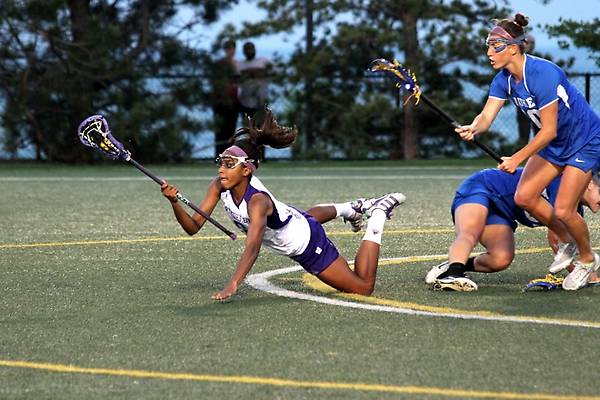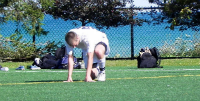
I run cross country here at Northwestern, and if my years of running have taught me anything, it’s that you always have to be a few steps ahead of yourself. Taking time to prevent injury from the insane amount of work you ask your body to do is crucial if you want to last the whole season.
Some injuries happen just as we imagine them. One second you’re this close to scoring the game winning goal, and the next you’re on the ground clutching your leg. Athletes risk acute injuries like muscle tears, sprains and broken bones every time they step out on the field.
Every injury is devastating in its own way, whether it’s a chronic pain like shin splints or an acute injury like an ACL tear. Both require months of rehab and caution. Either way, you miss out, and with only four short years to compete at the collegiate level, every season matters.
Katie Scott, an athletic trainer at Northwestern, said that research has found that women have higher rates of ACL tears and lower extremity overuse injuries. Women have wider hips than men, creating a greater angle from their hip to their knees.
“What that creates is a biomechanical change in the lower body,” Scott said. “So that is theorized to set up more abnormal forces in the lower extremity.”
ACL tears are one of the most common and devastating acute injuries. The ACL is a ligament in the knee that keeps the joint stable. It can be ruptured if you’re hit from the outside and your knee rolls inwards or if your knee hyperextends diagonally. Both can easily happen in contact sports if you’re hit with enough force in the wrong direction. At first you feel a sharp pain or a pop, but the pain goes away pretty quickly. So you stand back up, ready to get back in the game and your knee buckles from underneath you. The trainers rush out onto the field, and your knee begins to swell up.
From there, athletes have to wait until the swelling goes down and most of the mobility is back in the joint to surgically repair it. Therapy after surgery can be anywhere from eight to twelve weeks. Unlike overuse injuries, it’s hard to prevent acute injuries because they’re a product of uncontrollable situations. Scott says that athletes in contact sports have the highest risk of acute injuries, and certain positions in football and soccer are even riskier because they are involved in more plays. These athletes work to keep their glutes and hamstrings strong so that their body will be able to protect their ligaments and withstand more force.
Everyone risks injury simply by participating.

Not all injuries are like this. Some happen gradually over time, so slowly that you can’t even feel it happening until it gets really bad. Scott said that these overuse injuries happen most often to runners or in sports like lacrosse or soccer, where there is a lot of running.
So we, the sidelined athletes, bathe in ice and stretch and go to yoga and do corrective exercises. We cross train and try to stay off our feet and run on soft surfaces to reduce impact and lower the risk of overuse injuries. We adapt so we can train as long and as hard as possible without going over the line.
“You’re constantly adding repetitive forces to the musculoskeletal system over time and at some point, the body's inflammatory healing response exceeds the pain threshold for that individual,” Scott said.
That’s when you start feeling the pain. The problem is, the only way to get faster is to run longer or harder. And the best way to get injured is to run farther or faster week after week. So how do you walk the fine line between peak performance and being stuck on the sidelines?
“There are athletes that have chronic injury that deal with them all season long,” Scott said. “Can you prevent it 100 percent? No, you can’t. That’s just part of the sport, our bodies are meant to move certain ways and not everybody is created equal.”
In so many sports, you’re trained to push through the pain. With injuries, pushing through it without will only make it worse. You’ll feel a little twinge of pain and assume it’ll go away by the end of practice. Day after day, you keep thinking that nagging pain is a temporary thing. Denial sets in when you realize it’s not going anywhere.
Maybe you get hit in a game and it hurts, but you want to keep playing. You’re too competitive to stop and you don’t want to “give up.” Scott says these attitudes are what sets athletes back in the long run.
“Be smart to know when to pull back. I think that’s one of the biggest things athletes in varsity sports and intramural tend to overkill because of their personality, so they end up going above the threshold,” Scott said. “You can easily control these things.”
Controlling any type of injury, however, takes a lot of work on top of everything you already do to compete at a high level. I have so much respect for my teammates who have struggled with injuries. We all committed to run and compete, but when you’re hurt, you have to settle for ellipticals and pool running until you’re back on your feet again. Scott says the time spent in recovery is different for acute versus overuse injuries.

“Acute is just that: acute. It’s there, it happens, it heals, it should go away. When it doesn’t go away it becomes a chronic injury. The chronic ones are the ones that take a long time to come back fully from,” Scott said.
The only way to eliminate a chronic injury is to stop irritating it. In the world of Division I athletics, you can’t just stop when your body feels like it. There’s a competition schedule that will go on with or without you. So as long as it’s not dangerous to continue, trainers work to keep your chronic pain in check until the end of the season.
As an athlete, an injury shifts your entire lifestyle. You spend a lot more quality time in the training room with treatment and rehab exercises. You get zapped, poked, massaged, taped, scraped and iced back to health, hooked up to the all the machines in the training room. Injuries are almost more draining and time-consuming than being healthy, and you’re not even doing what you love. But you’re doing it to get back to what you love, and that makes the whole process worth it.
It takes so much self-discipline to push yourself through a hard cross-training workout while your teammates are out enjoying a run or practice together. Sometimes the stress of competing is overwhelming, but the minute you’re sidelined, you want nothing more than to compete again.
Injuries are no fun, but you truly gain a new appreciation for your health. When the daily grind gets a little overwhelming, you definitely feel more thankful that you’re even capable of participating. Even though you didn’t ask for it, you do get a break from your sport. But on your way back in, it's even easier to appreciate the opportunity you have to compete for the best school in the Big Ten.